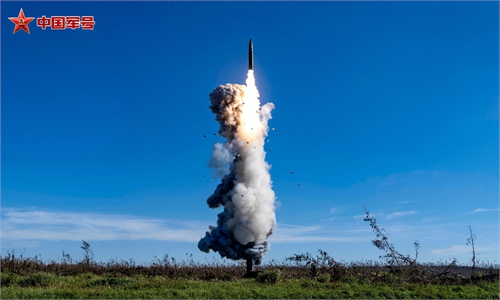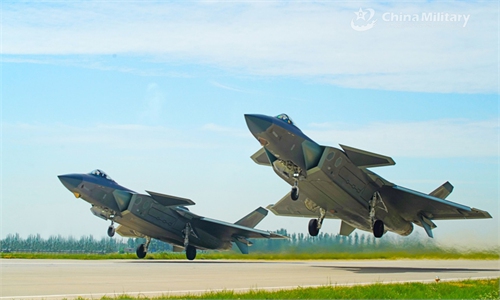
A photo taken in July 2016 shows a Chinese H-6K bomber patrolling islands and reefs including Huangyan Dao in the South China Sea. File photo: Xinhua
The Chinese People's Liberation Army (PLA) on Saturday conducted drills near China's Huangyan Dao in the South China Sea to safeguard sovereign security and maritime rights, which is believed to be a response to a joint maritime activity by the Philippines, the US, Australia, Japan and New Zealand on the same day, experts said.
The PLA Southern Theater Command deployed naval and air forces to carry out routine exercises including reconnaissance, early warning and sea-air patrols in waters and airspaces near China's Huangyan Dao on Saturday, the PLA Southern Theater Command said in a press release on the day.
Certain non-regional countries are stirring up trouble in the South China Sea and creating unstable factors in the region, the PLA Southern Theater Command said.
China has indisputable sovereignty over Huangyan Dao and its surrounding waters, and theater troops will remain on high alert, resolutely defend national sovereign security and maritime rights, and firmly safeguard peace and stability in the South China Sea, the press release reads.
Hours later, the PLA Southern Theater Command issued a second press release about the routine exercise.
These drills were conducted to assess the mission troops' capabilities in reconnaissance, surveillance, alert patrol, combat readiness and joint strike operations in real combat environments, the second press release reads.
Any attempts to stir up trouble in the South China Sea or create hot spot issues are under firm control, and the command troops remain on high alert, ready to counter any collusion acts that threaten regional peace and stability, said the PLA Southern Theater Command.
While the PLA Southern Theater Command did not elaborate on the actions by the certain countries from outside of the region, Reuters reported on Saturday that the Philippines, the US, Australia, Japan and New Zealand conducted a joint maritime activity "in the exclusive economic zone of the Philippines."
The PLA's exercise is routine, but its objective and aim are clear, that is to display China's determination, will and capabilities in defending its territorial sovereignty as well as peace and stability in the South China Sea, while sending a warning to the countries that are making waves in the South China Sea, Ding Duo, deputy director of the Institute of Maritime Law and Policy at China's National Institute for South China Sea Studies, told the Global Times on Saturday.
The joint maritime activity by the five countries will not significantly disturb the situation in the South China Sea, nor can it affect China's position, but it can encourage the Philippines to become more adventurous in making provocations on Chinese islands and reefs, Ding warned.
The increasing gatherings of non-regional countries with military activities in the South China Sea will raise concerns among ASEAN member states and coastal countries in the region, and it has become clear which forces are sabotaging peace and stability in the South China Sea, Ding said.
Military activities and media hype by non-regional countries are causing tensions and harming freedom of navigation in the South China Sea, observers said.
The Philippines-US-Australia-Japan-New Zealand joint maritime activity is said to be held in the Philippines' "exclusive economic zone," meaning it will likely enter sensitive areas where China and the Philippines have overlapping claims, Chen Xiangmiao, director of the World Navy Research Center at the National Institute for South China Sea Studies, told the Global Times.
Waters near Huangyan Dao are important because the island is located close to the Mindoro Strait and the Bashi Channel, both of which are strategic pathways the US military seeks to control in the event of a conflict, Chen said. He said that the PLA's exercise also served to practice the defense of the strategic lanes near Huangyan Dao.




